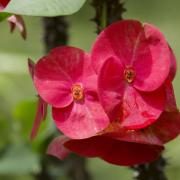The brightly coloured flowers of the houseplant cyclamen (Cyclamen persicum) are at their very best at Christmas and adorn many a festive table or are given as gifts.
Available in rich shades of dark purple through to red, cerise, pink, and white, there is a colour for any Christmas decorating scheme. I particularly like a bowl filled with fresh large white cyclamen in a silver, gold, and white themed dining room, together with a mini version wrapped in hessian with a table place name, for guests to take home.
Cyclamen have a reputation of dying quickly once in one’s home. This is not without basis; modern well insulated and centrally heated homes can be simply too hot for them. To ensure longevity keep them cool (10-15°C) is ideal. Perhaps a cool conservatory, porch or north facing windowsill without a radiator underneath. Just pop them on the Christmas table last minute. They also like to be watered from underneath so keep them moist and water into a saucer. If you do keep one going, be aware that they will eventually go dormant in summer just like other cyclamen, so once the leaves yellow and wither, store in the pot, dry until the autumn when you should repot the corm into fresh compost and water lightly. New growth will soon appear.
The mini cyclamen which have been available in garden centres throughout autumn and winter have similar bright colours, but as they are a cross between a non-hardy houseplant and fully hardy Cyclamen hederifolium, they can be used as container and hanging basket plants throughout autumn and winter, as they tolerate temperatures down to around -3°c. The odd one might become perennial if you are lucky, but generally they should be treated as a seasonal delight.
The prettiest Cyclamen, at least in my eyes, are the fully hardy, naturalising type. There are two main flowering seasons – in autumn Cyclamen hederifolium (Ivy-leaved cyclamen) delights with dainty reflexed flowers in shades of pink and white that appear before the foliage. As its name suggests, the leaves are shaped like those of the Ivy, and they are often beautifully marbled. Self-seeding freely (their seeds are carried to new areas by ants) they create beautiful drifts under trees and shrubs and even in grass. The flowers of Cyclamen Coum appear in the spring, after being in leaf throughout winter, and the flowers are smaller and perhaps slightly less elegant than their autumn counterparts, although I would hesitate in agreeing with some that they are ‘dumpy’! The leaves are more rounded and very attractive. Both Cyclamen grow best in fertile humus rich ground and are happiest in dappled or even full shade.
JOBS FOR DECEMBER
Gather planted pots together if possible, as they will shelter each other in poor weather.
Prune Wisteria now – remove whippy growth back to a couple of buds.
Japanese maples and Birch should be pruned now, if necessary. This reduces the risk of sap bleeding from the plant.
Make sure alpine and rockery plants have a top up of gravel around them to keep winter wet away from the stems.
Cover crops such as winter lettuce with fleece to keep them warm and net brassicas such as Purple sprouting broccoli against pigeons - they can ruin a crop overnight.
Apply grease bands to the trunks of fruit trees to prevent wingless female winter moths laying their eggs in the branches.
Clean the greenhouse on a bright day – disinfect benches as well as glass and frame to keep diseases to a minimum.
Bare root hedging can be planted if the ground isn’t frozen.



























